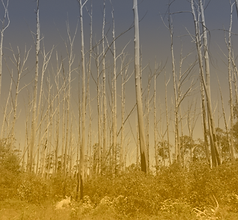
Bushfire Construction
Bushfire Attack Level (BAL) construction
CONSTRUCTION OF BUILDINGS IN BUSHFIRE PRONE AREAS:
AS 3959:2018
When building to a BAL rating, all buildings will need to meet the construction requirements of Section 3 of AS3959:2018 (General Construction Requirements) and the BAL Report will determine which additional construction requirements are required (Sections 4-9 of AS3959:2018).
Construction for all Bushfire Attack Levels (BAL):
There are 6 categories of Bushfire Attack Levels (BAL):
- BAL LOW * (Section 4) - not an option in Victoria
* The Victorian Building Regulations state that any development in a Bushfire Prone Area (BPA) must be built to a minimum of BAL 12.5.
To find out what the Bushfire Attack Level is for your new home, alteration and addition, shed, or subdivision, contact us to discuss your project and get a quote.
Or continue reading for reference guides of AS3959:2018 Section 3 and Sections 5-9.
Bushfire Attack Levels

Sections 3 & 5
Ember attack
radiant heat
below 12.5kW/m2.
Sections 3 & 6
Increasing ember attack and windborne debris, radiant heat between 12.5kW/m2
and 19kW/m2.
Sections 3 & 7
Increasing ember attack and windborne debris, radiant heat between 19kW/m2
and 29kW/m2.
Sections 3 & 8
Increasing ember attack and windborne debris, radiant heat between 29kW/m2
and 40kW/m2. Exposure to flames
from a fire front likely.
Sections 3 & 9
Direct exposure to flames, radiant heat and embers from
the fire front.
What does a BAL number mean?
A Bushfire Attack Level (BAL) is a measurement of the intensity of radiant heat from a bushfire, this is measured in kilowatts per square meter (kW/m2). In a bushfire, radiant heat levels may be unsafe for humans and could also ignite combustible materials in the vicinity. The potential effects of radiant heat levels on both humans and selected materials listed below can assist in understanding the implications of the different BALs.
Pain to humans after 10 to 20 seconds - 4kW/m2
Pain to humans after 3 seconds - 10 kW/m2
Self ignition of cotton after a long time - 25kW/m2
Self ignition of timber after a long time - 25kWm2
Self ignition of cotton after 5 seconds - 42kW/m2
Self ignition of timber after 20 seconds - 45kW/m2
A building that has been built to a Bushfire Attack Level (BAL) in accordance with Australian Standards - Construction of buildings in bushfire prone areas (AS3959:2018) is primarily concerned with improving the ability of buildings to better withstand attack from a bushfire giving the occupants a measure of protection until the fire front passes as well as to the building itself.
A building that is built in accordance with AS3959 is not a guarantee that the house will not be impacted or destroyed by a bushfire. This is substantially due to the degree of vegetation management, the unpredictable nature and behaviour of fire, and extreme weather conditions. The survivability of buildings is also dependent on a combination of measures such as landscaping, water supplies, access, building design and maintenance.







